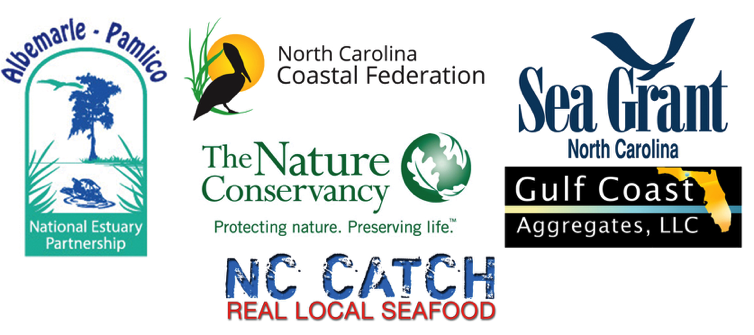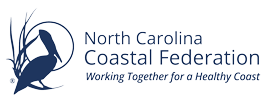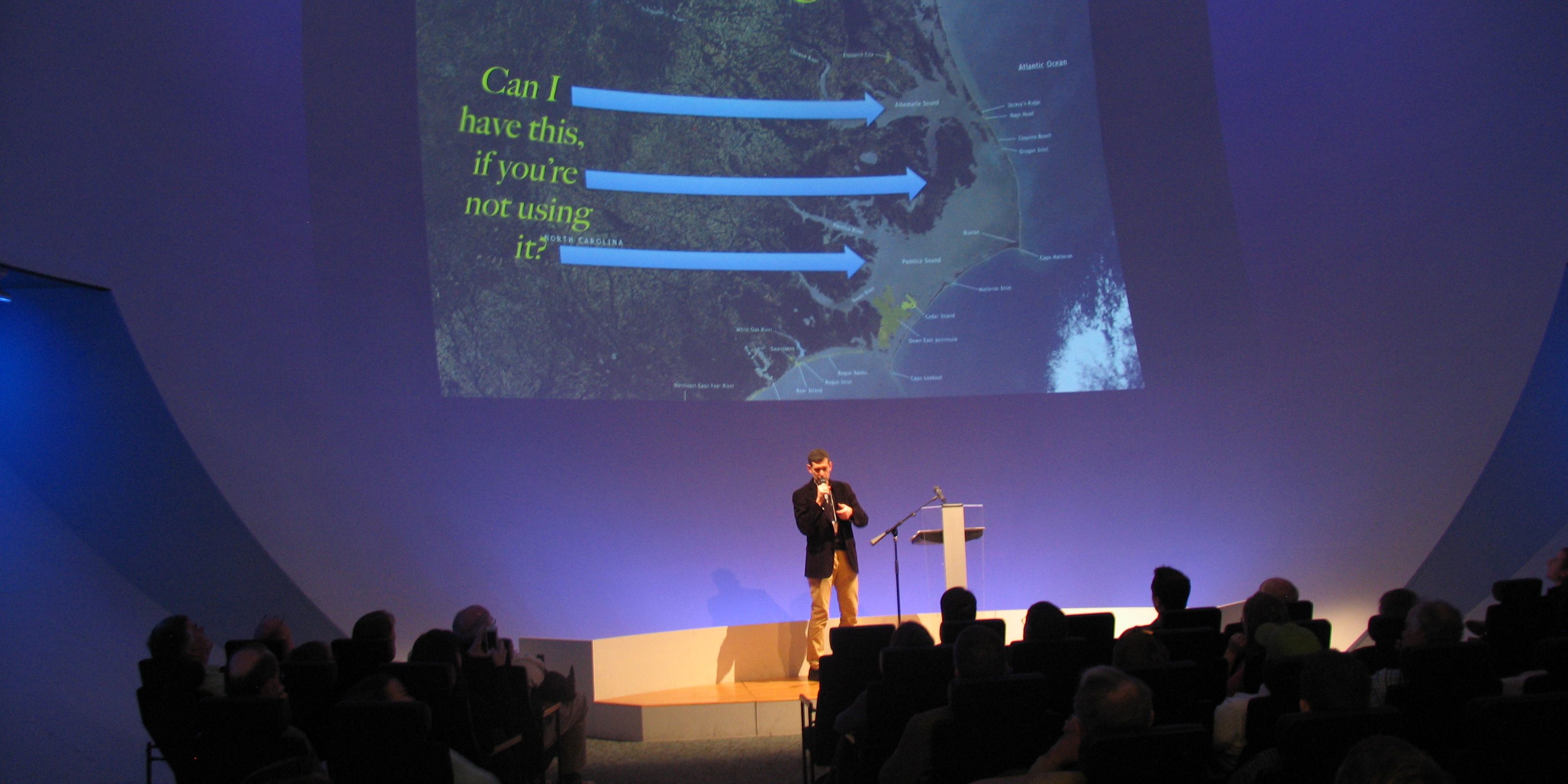
The N.C. Oyster Summit: Promoting a Healthy Coastal Environment and Economy
March 10-11 2015
More than 150 state legislators, commercial fishermen, mariculturists, government, academic, private and non-profit professionals met in Raleigh to explore the economic and environmental returns on investing in North Carolina’s oyster restoration, enhancement and production. The Summit, focused on exploring strategies and actions as outlined in the updated Oyster Blueprint for Action.
The Oyster Blueprint is a living document, created in 2003, that links oyster and coastal habitat restoration with water quality and watershed restoration; fishery enhancement and mariculture development; and public engagement and stakeholder leadership.
The summary below outlines some of the key discussion points, conclusions and recommendations developed during the Summit.
Participants at the Summit were in agreement that North Carolina has a great opportunity to spark considerable economic growth AND environmental improvement by investing in its oyster fishery and coastal restoration.
This consensus is based on strong evidence of the:
- Environmental and economic returns that can be realized from habitat and water quality restoration,
- Opportunities for public and private partnerships and the significant expansion of private sector involvement in habitat and water quality restoration,
- Small business growth opportunities related to mariculture and coastal restoration
- Impact of mariculture and related coastal restoration can have on coastal economies, particularly in rural coastal counties.
In addition, many participants noted that the benefits of restoring the state’s oyster industry could be done in a way that complements its coastal tourism economy and the unique character of our coastal communities.
The economic benefits of coastal restoration were also confirmed in a recently released report by RTI International, an independent, nonprofit research company.
State Representative Paul Tine keynoted the event with a powerful message, calling for continued support of clean water and oyster restoration efforts in the state.
Rowan Jacobsen, author of A Geography of Oysters, spoke just prior to the legislative reception and suggested that N.C. is well poised, to become the “Napa Valley of Oysters.” Referring to North Carolina as a “sleeping giant” that once awoken, could rival Washington State (the largest producer of cultivated oysters in the country) and Virginia (the fastest growing oyster producing state, growing from $250,000 in 2005 to $45 million in 2014).
The summit confirmed that promoting oyster restoration and mariculture activities benefits both the habitat and economy. Together the group will continue to explore and implement strategies that will promote both including:
- Explore regulatory reform to facilitate the opportunities for mariculture and restoration alike,
- Strengthen public institutions’ capabilities to support coastal restoration and mariculture development (UNCW Shellfish Research Hatchery, SeaGrant Fishery Resource Grants, N.C. Division of Marine Fisheries mapping and habitat enhancement),
- Restore and protect priority watersheds so that our waters remain clean and healthy to support these efforts and this growing industry,
Communicate the value and importance of these efforts to the public and decision makers at a state and national level.
Summit Objectives:
- Explore the economic and environmental returns on investing in North Carolina oyster restoration, enhancement and production.
- Update the Oyster Blueprint for Action to rebuild North Carolina oyster habitat, stocks and fisheries, and to improve the state’s coastal water quality and economy.
- Discuss prioritized scientific challenges to implementing successful oyster restoration strategies in North Carolina.
Agenda:
Tuesday, March 10
Welcome and Introduction to the Summit
- Erin Fleckenstein, N.C. Coastal Federation
Keynote: Clean Water as Infrastructure
- N.C. Representative Paul Tine (I), District 6
The N.C. Experience: The History of Oyster Management Over the Past Century
- Dr. Louis Daniel, Director, N.C. Division of Marine Fisheries
The Importance of Oysters in Providing for Healthy Coastal Ecosystems
- Dr. Martin Posey, University of North Carolina Wilmington
- Dr. Mike Piehler, University of North Carolina Institute of Marine Sciences
The Importance of the Oyster Fishery to Coastal North Carolina
- Bradley Styron, Quality Seafood
Facilitator: Ted Wilgis, N.C. Coastal Federation
Panelists:
- Dr. Pete Peterson, University of North Carolina, Institute of Marine Sciences
- Dr. Dave Eggleston, North Carolina State University Center for Marine Sciences and Technology
- Dr. Ami Wilbur, University of North Carolina Wilmington
- Dr. Bill Crowell, Albemarle-Pamlico National Estuary Partnership
- Jason Peters and Brian Conrad, N.C. Division of Marine Fisheries
Setting Restoration Goals for the Next Decade
- Dr. Brandon Puckett, National Estuarine Research Reserve, Division of Coastal Management
Why Restoring Oysters Makes Economic Cents
- Facilitator: Tom Looney, Lenovo & N.C. Economic Development Board
- Panelists: Sara Lawrence, Research Triangle Institute Dr. Pete Peterson, University of North Carolina Institute of Marine Sciences
Looking Ahead: Key Challenges and Questions to Be Addressed
- Todd Miller, N.C. Coastal Federation
Rowan Jacobsen, the award-winning author of A Geography of Oysters, will offer an energizing and lively discussion about the uniqueness and varieties of oysters, how North Carolina plays a role in the global oyster market, and the conservation value of cultivating oysters and keeping waters clean to support this growing industry.
Legislative Reception
Wednesday, March 11
Goals for the Day: Defining Goals and Objectives for the Next Five to Ten Years
- Erin Fleckenstein, N.C. Coastal Federation
Linking Restoration of Oysters to an Economic Development Strategy for Coastal N.C.
Facilitator: Raj Narayan, Kenan Institute for Engineering, Technology & Science
Panelists:
- Rob Lamme, N.C. Coastal Federation
- Dr. Andy Keeler, Coastal Studies Institute
- Simon Rich, Stevens Towing
- ohn Preyer, Restoration Systems, LLC
Sanctuary Strategies for the Next Five Years
Facilitator: Erin Fleckenstein, N.C. Coastal Federation
Panelists:
- Curt Weychert and Jason Peters N.C. Division of Marine Fisheries
- Justin Bashaw, U.S. Army Corps of Engineers
- Dr. Troy Alphin, University of North Carolina Wilmington
- Dr. Dave Eggleston, N.C. State University Center for Marine Sciences and Technology
Cultch Planting Strategies for the Next Five Years
Facilitator: Willy Phillips, Full Circle Crab Company
Panelists:
- Chris Conoway, Conoway Marine Construction
- Jim Swartzenberg, J&B Aquafood
- David “Clammerhead” Cessna, Commercial Fisherman and Collaborative Researcher with University of North Carolina Institute of Marine Sciences
- Dr. Louis Daniel and Garry Wright, N.C. Division of Marine Fisheries
- Dr. Niels Lindquist, University of North Carolina Institute of Marine Sciences
Oyster Mariculture Priorities for the Next Five Years
Facilitator: Sara Mirabilio, North Carolina Sea Grant
Panelists:
- N.C. Senator Bill Cook (R) District 1
- Marc Turano, Pentair Aquatic Eco-Systems, Inc.
- Jay Styron, Carolina Mariculture Co. University of North Carolina Wilmington, & President,
- N.C. Shellfish Growers Association
- Brian Conrad, N.C. Division of Marine Fisheries
- Patti Fowler, N.C. Division of Marine Fisheries, Shellfish Sanitation
Managing Oysters on Public Bottom
Facilitator: Trish Murphey, N.C. Division of Marine Fisheries
Panelists:
- Dr. Ami Wilbur, University of North Carolina Wilmington
- Tina Moore, N.C. Division of Marine Fisheries
- Adam Tyler, Commercial Fisherman and Collaborative Researcher with
- University of North Carolina Institute of Marine Sciences
- Shannon Jenkins, N.C. Division of Marine Fisheries, Shellfish Sanitation
Watershed Management Priorities for the Next Five Years
Facilitator: Dr. Lexia Weaver, N.C. Coastal Federation
Panelists:
- Ted Wilgis, N.C. Coastal Federation
- Dr. Mike Burchell, N.C. State University
- Jamin Simmons, Mattamuskeet Management and Consulting
- Hunter Freeman, Withers & Ravenel
- Erin Carey, City of Wilmington
- Steve Murphey, N.C. Division of Marine Fisheries, Shellfish Sanitation
Facilitated Discussion: www.ncoysters.org: Information needs and components for a working restoration database.
Facilitator: Jim Hawhee, Albemarle-Pamlico National Estuary Partnership
The 2015 N.C. Oyster Summit is sponsored in part by:


